Future Support and Advice to Rural Communities
This report explores the nature and level of existing support and advice available to rural communities in Scotland.
6 RURAL DIRECT
Profile of Rural Direct
6.1 Rural Direct is funded by the Scottish Government and delivered by SCVO. It is a national funding advice and support service for rural community groups or community enterprises at any point in their journey from idea development to programme delivery for any type of project (including community energy, youth groups, social enterprise, community transport, asset transfers). While being nationally available, many aspects of the service were delivered locally. In Orkney and Shetland, Voluntary Action Orkney and Voluntary Action Shetland staff delivered aspects of the Rural Direct service locally.
6.2 While Rural Direct has been an open, generic, national service, other national providers are thematic (e.g. Development Trusts Assocation Scotland or Community Woodlands Association or Community Shares Scotland), and much provision of funding advice and support services is at a local level (e.g. including but by no means limited to LEADER or Third Sector Interfaces). Any future provision must take specific account of the National Rural Network's work as a network.
6.3 The merit identified by Rural Direct of a national programme supplementing the existing provision from the "cluttered landscape" of providers is that it is able to:
- Draw on learning and examples from across the country
- Provide some degree of lobbying, advocacy and policy work at a national level
- Have a single national brand and so help to enhance awareness.
6.4 The support that Rural Direct has been offering over 2009 - 2014 has changed a little each year and has been scaled back in more recent years while the Scottish Government reviews its funding strategy. As an indicator of the level of funding that Rural Direct received, Scottish Government contributed £254,388 in 2012/13, the last year in which Rural Direct received funding for the whole service rather than just the database.
6.5 In general the focus of the work has been in offering one to one advice to community groups through development officers. It has also produced resources (online and offline), provided an 0845 helpline number for funding issues, supported local funding advice services, and delivered training, events and roadshows.
6.6 SCVO has produced quarterly monitoring reports of Rural Direct's activity and outcomes. These were structured around particular target outcomes, which changed somewhat over the years, particularly between 2011/12 and 2012/13 (see Figure 18) when eight key performance indicators (KPIs) were introduced. Generally, activity in the earlier years had a greater focus on raising the awareness of the Rural Direct service itself and about SRDP funding, while later years had a more general focus and included the provision of a database to signpost community groups to all the available sources of funding advice in their area.
6.7 Awareness raising activities included e-newsletter dissemination, circulating leaflets, press articles and radio interviews. Rural Direct also provided training (training packages, briefings, and training events) for both funding advice providers and for community groups. In 2011/12 Rural Direct worked with "community groups, funding organisations, Third Sector Interfaces and Local Authority staff" to plan and deliver Rural Direct Roadshows across Scotland. These roadshows provided community members a chance to meet and talk to "funders and other experts" about access to funding.
Figure 18: The changing outcomes of Rural Direct
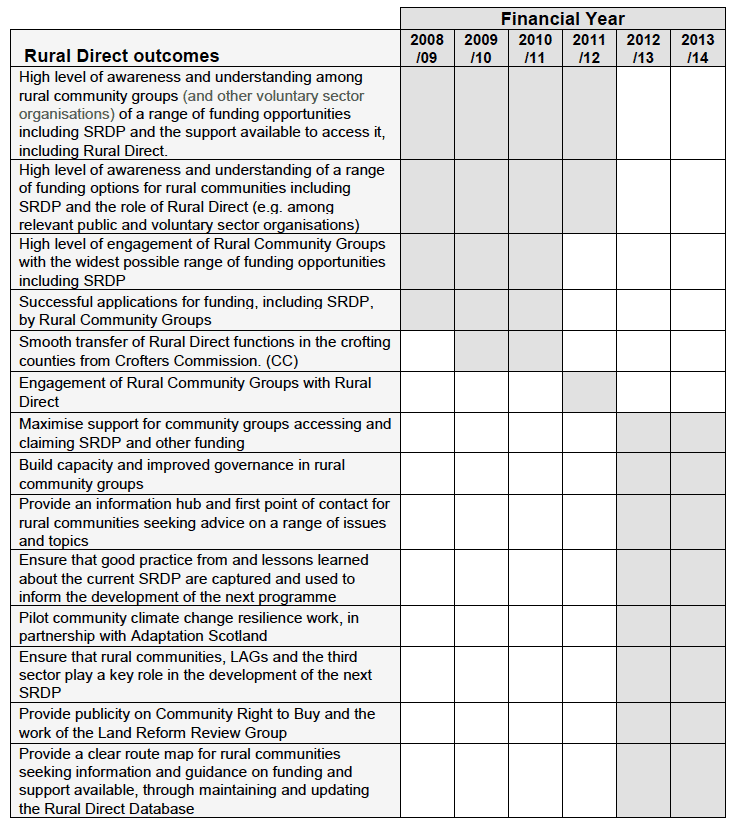
6.8 Rural Direct has provided a service to help community groups understand policy changes. For example, Rural Direct reported an increase in their helpline's activity in the quarter October-December 2009 related to the Rural Priorities Services and Facilities option being transferred into the LEADER programme and the subsequent impact on community groups who had already submitted a funding application.
6.9 Understanding the scale of interaction of the whole Rural Direct service is challenging, because of the ways in which the service has evolved between 2008/09 and 2013/14. SCVO reported on the number of events and community groups engaged with its service on a quarterly basis. Some of the ways in which this information was reported, particularly in the first few years of delivery, is not easy to interpret. As an example, between 2008/09 and 2011/12, reporting of one-to-one advice sessions between Rural Direct development officers and community groups to discuss funding options, emails to provide a community group information and a "telephone call enquiry about the position of the application for funding" were reported under the category of "awareness-raising events", as were discussions between Rural Direct and funding advice providers. These "events" therefore vary widely, in both their nature and their intensity. In 2012/13, reporting was altered significantly and aligned closely to eight KPIs.
6.10 In terms of the scale of active engagement with community groups, by the end of quarter 2 in 2012/13 (when reporting on this changed) there were 1,110 community groups which SCVO reported had received a high level of assistance / were actively engaged with the service (Figure 19). Much of this active engagement appears to have focused on support to access SRDP funding, although the sharp rise in engagement in 2011/12 was due to the inclusion of community groups who were actively engaged by attending Rural Direct roadshows, at which they met "funders and other experts" about access to funding.
Figure 19: The number of projects/groups engaged with Rural Direct, with a step change in 2011/12 associated with increased reach through roadshows
| Financial Year |
|||||
|---|---|---|---|---|---|
|
|
2008/09 |
2009/10 |
2010/11 |
2011/12 |
2012/13 |
| No of active Community Projects / Community Groups receiving information and advice from Rural Direct |
346 |
258 |
|
||
| Cumulative number of Community Groups Assisted |
|
|
486 |
1,019 |
1,110 |
6.11 We tracked the scale of the offer provided by the national 0845 helpline by assessing quarterly reports (see Figure 20). In 2009/10 - the time of peak activity regarding the helpline - the service was receiving just under one enquiry per day. In 2012/13, this was much lower, at just one call every five days.
Figure 20: The scale of the number of enquiries to the Rural Direct helpline
| Financial Year |
|||||
|---|---|---|---|---|---|
|
|
2008/09 |
2009/10 |
2010/11 |
2011/12 |
2012/13 |
| Enquiries to Rural Direct Helpline |
136 |
297 |
263 |
256 |
78 |
6.12 The email subscription list size for Rural Direct communications grew to over 1,500 groups/individuals in 2012/13. The latest estimate of scale is that the survey as part of this research was sent by SCVO to 1,621 email addresses on the Rural Direct database who SCVO believed were beneficiaries of their services. The Rural Direct newsletter currently goes to 2,258 email addresses.
6.13 For quarters beyond quarter 3 in 2012/13, information was recorded against the new KPIs. The distinction between different elements of support in these reports helps to show the full range of activities undertaken by Rural Direct, and the number of different groups that the service engaged (e.g. community groups, third sector interfaces and LEADER Local Action Groups). A further service that Rural Direct has been involved with in the last two years is the KeyStone quality award and management toolkit for people who manage village halls and community buildings[3].
6.14 Example outputs are shown in Figure 21 below - this shows that the scale of the service has reduced somewhat, especially in terms of people using the telephone helpline service.
Figure 21: Profile of recorded outputs in 2012/13 and 2013/14
|
|
2012/13 |
2013/14 |
||
|---|---|---|---|---|
| Q3 |
Q4 |
Q1 |
Q2 |
|
| 1. Maximise support for community groups accessing and claiming SRDP and other funding |
||||
| Number of community groups supported for SRDP and/or non-SRDP funding |
114 |
62 |
69 |
79 |
| Number of other groups supported (e.g. LAGs, public sector groups) |
15 |
8 |
14 |
20 |
| Number of training events run in person |
4 |
4 |
2 |
|
| Number of training events run by phone |
||||
| Number of training events run online, as webinars |
1 |
2 |
||
| 2. Build capacity and improved governance in rural community groups |
||||
| Communications, information and briefing provided to TSIs and other national and local support organisations |
4 |
5 |
5 |
11 |
| Meetings and other engagement with TSIs and other local support organisations |
9 |
15 |
22 |
15 |
| Training and information events run with TSIs and other local and national support organisations |
15 |
4 |
1 |
2 |
| KeyStone: Number of groups registered |
53 |
6 |
5 |
5 |
| KeyStone: Number of mentors trained |
64 |
0 |
0 |
0 |
| KeyStone: Number of awards |
7 |
2 |
0 |
2 |
| 3. Provide an information hub and first point of contact for rural communities seeking advice on a range of issues and topics |
||||
| Number of subscribers to email newsletter |
1658 |
1597 |
1562 |
1560 |
| Number of telephone inquiries |
21 |
12 |
9 |
7 |
| Number of email inquiries* |
32 |
22 |
11 |
8 |
| 6. Ensure that rural communities, LAGs and the third sector play a key role in the development of the next SRDP |
||||
| Number of facilitated workshops |
1 |
2 |
5 |
0 |
| Briefing papers on consultation on new programme |
2 |
0 |
||
| Presentations delivered on consultation on new programme |
5 |
0 |
||
| Articles, blogs and social media updates |
6 |
5 |
3 |
|
Awareness of Rural Direct
Awareness amongst Community Groups
6.15 We gathered evidence on the awareness of Rural Direct among community groups through online survey, telephone interview and paper surveys completed at the Rural Parliament workshop.
6.16 First, we asked respondents to name sources of funding and advice and support that they were aware of. This may be considered an unprompted query of how many respondents included Rural Direct in their response. Of 165 respondents, seven (4%) mentioned Rural Direct unprompted, while 24 in total (15%) mentioned SCVO.
Figure 22: An unprompted query about awareness of Rural Direct - asking community groups to name sources of funding advice and support of which they were aware.
| # of Responses | Proportion of respondents (n = 165) | |
|---|---|---|
| Mentioned Rural Direct (total) | 7 | 4% |
| Mentioned SCVO (total) | 24 | 15% |
| Mentioned SCVO and Rural Direct | 3 | 2% |
| Mentioned one of SCVO or Rural Direct or Rural Network | 32 | 19% |
6.17 Although very few respondents cited Rural Direct, this may be related to the fact that Rural Direct has not been fully operational in recent months. Due to this possibility (i.e. that respondents may have in the past cited Rural Direct but now forgotten about it) we also tested awareness of Rural Direct by asking community groups if they would use Rural Direct for funding advice, amongst a list of other funding advice services. Of 185 respondents, 31 (17%) said that they would go to Rural Direct (Figure 23 below).
Figure 23: A second test of awareness of Rural Direct - would community groups go to Rural Direct for advice and support?
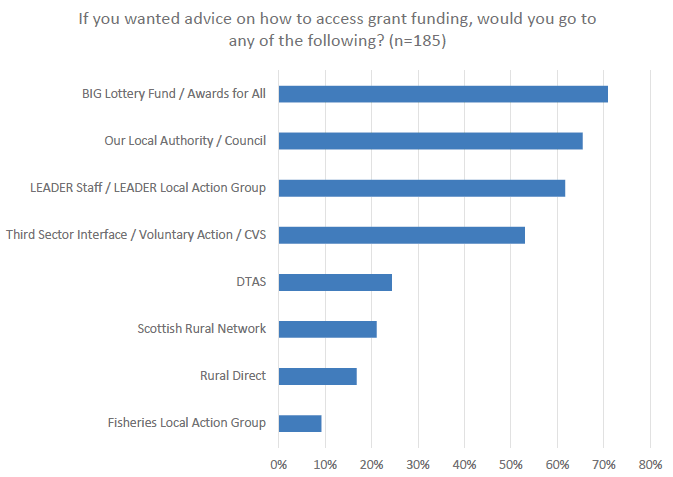
6.18 In a third question, community groups were asked directly if they had heard of Rural Direct and if they had heard of specific elements of Rural Direct's support (Figure 24 below). In this case, more than one third (36%) of respondents indicated that they had heard of Rural Direct. This is much higher than for other tests of awareness, but still represents a minority of respondents. Groups were most aware of Rural Direct's events, briefings and roadshows, with only 11% of respondents being aware of Rural Direct's one to one support service.
Figure 24: A third, direct test of awareness of Rural Direct
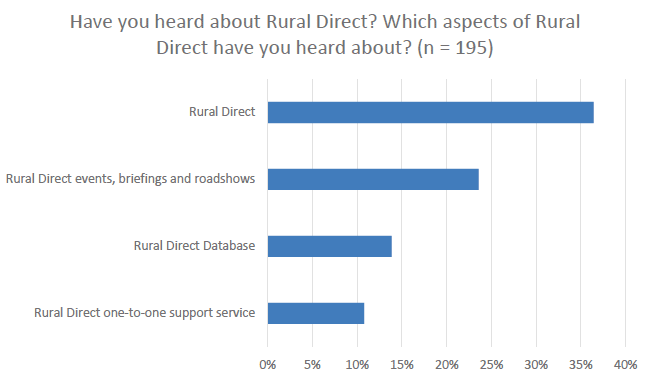
6.19 Overall, these results indicate that most groups (i.e. potential Rural Direct customers) are not aware of Rural Direct. However, as we identified earlier in this report, there is a deeper problem that many do not know that any funding advice and support exists: many were not aware that LEADER or their Third Sector Interface might offer this - and some had heard of neither. This both makes the case for a national service - providing a single easily recognised brand - and also undermines the case for the existing service as there is still low awareness after five years of delivery.
6.20 However, It should be noted that current low levels of awareness do not prevent Rural Direct being an asset or nationally important, especially given the fact that the service has been scaled back.
Awareness amongst Advice Providers
6.21 As well as consulting community groups, we also asked advice providers about their awareness of Rural Direct. Most (75% of 99) respondents had heard of Rural Direct but a smaller proportion (35% of 65) had made referrals (i.e. directed community groups to Rural Direct) in the past (Figures 25 and 26 below).
6.22 In terms of the extent of knowledge about different aspects of Rural Direct, respondents were most likely to say that they knew at least a little bit about Rural Direct's events, briefings and roadshows, with around half of respondents indicating that they didn't really know much about what the Rural Direct database or what Rural Direct's one-to-one service is.
6.23 We note that one respondent was confused about Rural Direct and the National Rural Network, saying
"[I] found the relationship to National Rural Network and the National Rural Network website etc. confusing - how was Rural Direct different?"
Figures 25 and 26: Advice providers' level of awareness of Rural Direct, and whether they had made referrals to Rural Direct
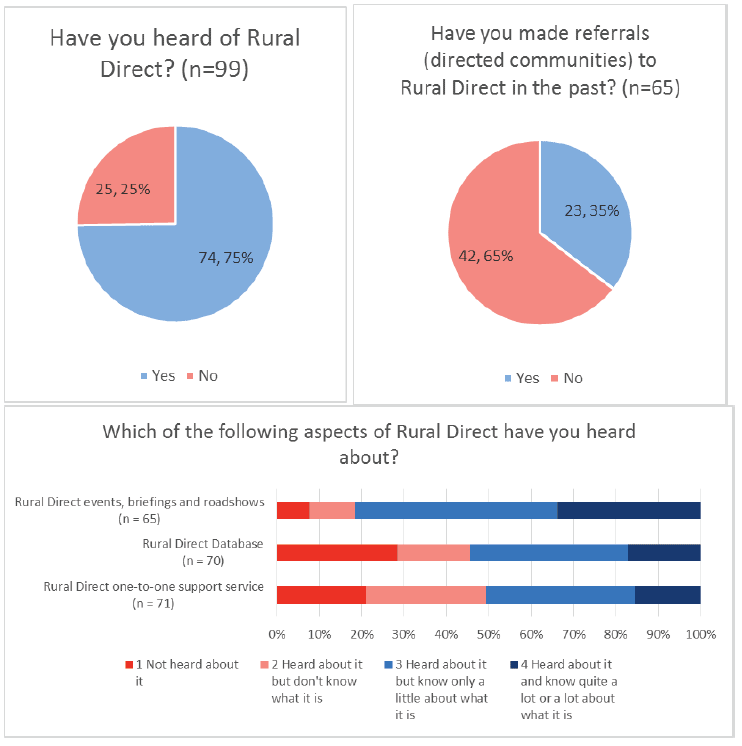
Feedback on Rural Direct
6.24 We have gathered evidence of the quality and reach of Rural Direct support from community groups and advice providers.
Feedback from Community Groups
6.25 Of community groups who had heard of Rural Direct, 29 provided a response about the strengths and weaknesses of Rural Direct. This is a small proportion of the overall sample, suggesting that few people had felt able to comment on Rural Direct.
6.26 Responses were very mixed. Five respondents (17%) gave a positive response, eight (28%) a negative response and four (14%) a mixed review. A further 38% said that they didn't know enough about the service to comment. These responses are shown below.
6.27 Positive responses described staff as being knowledgeable and the service as being responsive and focused, for example:
"Responsive and focused."
"Staff are very knowledgeable and have a range of information at their fingertips. We don't often get this kind of direct support to rural communities."
"Rural Direct staff were ahead of the game when we had issues with SRDP projects."
6.28 Some negative responses cited frustration at the online site, and lack of appreciation that the service was more than a website, for example:
"Unable to find what I needed on the website. I have found the site to be hard to navigate and gave up."
"It is difficult to navigate the website and understand where information that is relevant to your needs might be. It is also difficult to ascertain how to get support, and what kind of organisations are eligible for support. Until this survey I had not appreciated I could just pick up the phone to someone and ask."
Another respondent echoed this point about a lack of information about what the service delivers:
"Not advertised widely enough. Didn't know about the database. Not present at many of the sector events I've attended. Thought they were more signposting than actual support."
Other comments cited frustration with contact with Rural Direct staff's responsiveness and knowledge:
"I spoke at a conference for Rural Direct a few years ago and asked for a rep to come out and meet with us and after a few phone calls I gave up."
"An extremely unhelpful service with dis-interested staff unless they had an existing relationship with you. Staff unsure of the facts and information that they were giving out - not well trained. Staff making biased decisions."
One respondent said that the service was not focused and its role unclear:
"A little 'all things to all people'. Duplicating work of local organisations. Confusion re social enterprise remit."
6.29 Mixed reviews echoed the conflicting viewpoints cited above. Notably, one respondent cited the helpfulness and expertise of staff but said they perhaps did not have capacity to be accessible:
"…his (and other staff's) expertise excellent and greatest strength. Areas of weakness perhaps accessibility as they were hugely busy."
Issues of duplication were cited, and again the need for greater advertising of the service:
"The staff are always helpful, though the information often duplicates that from other sources."
"I think Rural Direct is a good idea but perhaps needs to be advertised a bit better. Needs to be more prominent."
Roadshows were cited as being helpful and informative:
"Roadshow very helpful and informative, e-newsletters are one of many so often not able to read them due to other time commitments."
Feedback from Other Advice Providers
6.30 Advice providers were asked (online survey, one-to-one interview) to give opinions about the quality of elements of the Rural Direct service. Only a small set of respondents provided answers on these questions, suggesting that respondents did not feel able to comment on the quality. Unfortunately this means that it is difficult to draw a high degree of confidence in advice providers' opinions of the service; the views of the small sample who responded are shown below.
6.31 Regarding the Rural Direct database, there was a mix of views amongst the small sample who responded, but the majority of the small sample rated the quality as either 1 or 2 out of 4 (Figure 27).
Figure 27: Advice providers' view of the quality of the Rural Direct database (Sample 9)
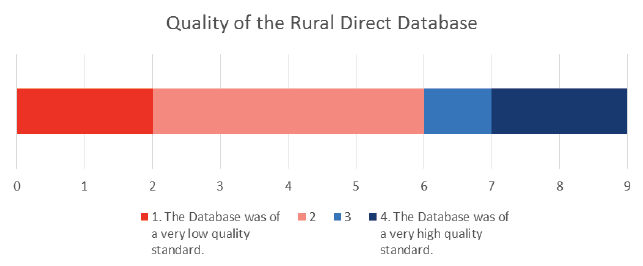
6.32 Regarding Rural Direct's one-to-one services, responses were much more favourable amongst the small sample who responded, with the majority of the small sample rating this as 3 or 4 out of 4 (Figure 28 below). We also asked advice providers about the level of impact they thought that the service had had on community groups who were strongly engaged with it - again, responses were positive overall from small sample.
Figure 28: Advice providers' view of the quality and impact of the Rural Direct one to one service (Sample 8 and 6)
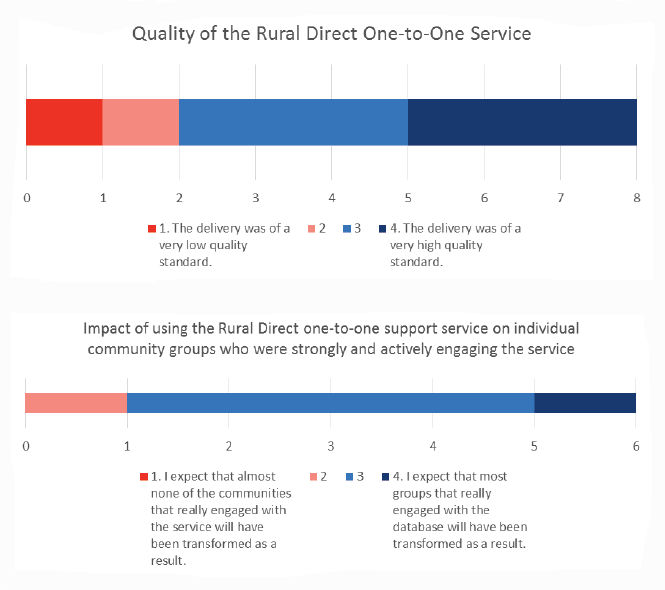
6.33 Advice providers were also asked for any final comments about Rural Direct in terms of its importance, quality and impact. 21 respondents provided a view, with four giving a positive review, five giving mixed reviews and 12 giving mostly critical reviews. Positive reviews referenced support for an individual organisation around accessing SRDP funding, useful briefings and dedicated support for rural communities, and comments on the staff being approachable and good to work with, for example:
"We have had one to one support in Midlothian for one organisation from Rural Direct and this was in connection with SRDP funding. This specific support was extremely helpful and did make a real difference to the organisation in terms of its ability to access the funding."
"Briefings useful and dedicated support for rural communities also useful"
6.34 Notable amongst mixed reviews were the following remarks, which highlighted a mix of quality in delivery, including positive remarks about the database and some examples of groups "gaining something" from working with Rural Direct, but also more negative experiences of support from Rural Direct.
"The [organisation] team responded in a variety of ways. Some had not referred clients to Rural Direct and some, when they did, felt that the support was inadequate. Others found that the clients gained something. This was mainly around SRDP support rather than in general funding terms."
"My one experience of working with a group which received support from the service was actually quite negative I'm afraid to say…. on the other hand the roadshows which attempted to de-mystify SRDP and raise awareness of funding opportunities could be useful if properly done in conjunction with support agencies on the ground".
"The National database is helpful in showing groups what others have achieved, but I still believe deploying a local worker via the Rural Partnership or Local Authority would be more cost effective and provide timeous help in terms speed, time and project development and have a local along with national knowledge"
6.35 Amongst more negative reviews, the service was described as "patchy, incoherent and generalist"; as "working in a vacuum" and giving "misinformation…to groups causing delay and frustration for the applicants"; and as being "not relevant to very rural areas". Other remarks said that the database is "not good enough…scanty info" and that Rural Direct had "not really had the reach it might have had".
6.36 The general impression from the comments is that there has been some value of the service noted, especially around the SRDP programme, but that the service has been "patchy" and not fully integrated with local delivery to the extent that other local organisations would have liked. This impression was explicitly stated by one respondent:
"Useful re specialist advice on SRDP but support was often limited to technical advice rather than support to the applicant, which was provided locally by either LA or CVS."
Contact
Email: Liz Hawkins
There is a problem
Thanks for your feedback